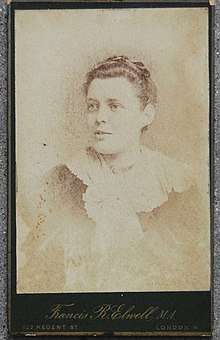Elizabeth Margaret Pace
| Elizabeth Pace | |
|---|---|
 | |
| Born |
1866 Lambeth, London |
| Died |
1957 (aged 90–91) St Andrews |
| Nationality | English |
| Occupation | Doctor |
| Years active | 1884 - |
| Known for | Medicine |
| Medical career | |
| Field | obstetrics |
Dr Elizabeth Pace (1866 - 1957) was a Scottish doctor, suffragist and advocate for women's health and women's rights.
Early life and education
Elizabeth Margaret Pace was born in Brixton in 1866. Her father, Thomas Richard Pace was a leather manufacturer. Her mother's name was Margaret Gibb. She was the eldest of four. She attended Clapham High School.[1] In 1884, she matriculated in the London School of Medicine for Women. She graduated in 1891.[2] In 1892, she was presented to the chancellor at Burlington House, where she was noted for having an award in obstetrics.[3]
Medical career and charitable work
During her career, she worked in a number of institutions, in London, Glasgow and Scotland,[2] including:
- New Hospital for Women
- Gynecology department, Bellahoustoun Dispensary
- Lock Hospital, Glasgow
- Victoria Infirmary Dispensary
- Glasgow Women's Private Hospital
- St Margaret's School, Polmont
She was involved in a number of organisations with charitable aims, with a particular focus on women's work and health, many alongside her housemate, and colleague, Dr Alice McLaren. In 1893, she was elected honorary member and medical officer of the Ancient Order of Foresters, a friendly society. She was also associated with the Scottish Women's Benefit Association,[4] and the Glasgow and West of Scotland Co-operation for Trained Nurses.[5] She was a member of the Glasgow Obstetric and Gynecological Society.[6] In 1902, she was involved in founding the Glasgow Women's Private Hospital alongside Alice McLaren. She retired from the hospital in 1908, but "she retained her interest in the hospital and remained on the executive committee."[7]
She lectured on various subjects related to health, in institutions such as John Street public school, with Dr Alice McLaren;[8] Kilmarnock school board,[9] and the Logan and Johnston school of domestic economy in Bridgeton.[10] She had a particular interest in temperance, speaking at a conference on the subject, alongside Sophia Jex-Blake.[11] She also spoke on the importance of exercise for women.[12][13]
Later life
During her time in Glasgow, she shared a house with Dr Alice McLaren at 7 Newton Place. She married Andrew Maitland Ramsay in 1907.[14] She died in St Andrews in 1957.

Women's rights
She was a founder member of the Glasgow and West of Scotland Association for Women's Suffrage.[15]
References
- ↑ University of London Student Records 1836-1936, Senate House Library. 1884.
|access-date=requires|url=(help) - 1 2 The Medical Directory. 1900.
|access-date=requires|url=(help) - ↑ "A large number of the graduates of the". Glasgow Herald. 12 May 1892. Retrieved 2018-06-16 – via Newspapers.com.
- ↑ "Scottish Women's Benefit Society". Glasgow Herald. 20 November 1893. Retrieved 14 June 2018 – via Newspapers.com.
- ↑ "Glasgow and West of Scotland Co-Operation for Trained Nurses". Glasgow Herald. 5 October 1894. Retrieved 14 June 2018 – via Newspapers.com.
- ↑ Medical Directory. 1895.
|access-date=requires|url=(help) - ↑ Menzies Campbell, Margaret (1948). Campbell, Margaret Menzies (1948) Three Scottish Women’s Hospitals from their foundation until 1948. Bruntsfield Hospital, Edinburgh. Dundee Private Hospital for Women. Glasgow [Redlands] Private Hospital.
|access-date=requires|url=(help) - ↑ "School Board of Glasgow". Glasgow Herald. 30 October 1895. Retrieved 14 June 2018 – via Newspapers.com.
- ↑ "Ardrossan and Saltcoats Herald". 17 January 1896.
- ↑ "The Logan and Johnston School". Glasgow Herald. 26 January 1898. Retrieved 15 June 2018 – via Newspapers.com.
- ↑ "The Conference of Women Workers". Leeds Mercury. 26 October 1894. Retrieved 15 June 2018.
- ↑ "Dundee Evening Telegraph". Dundee Evening Telegraph. 29 July 1904. p. 4.
- ↑ "Northern Whig". Northern Whig. 29 July 1904. p. 10.
- ↑ "Concerning Women". Altoona Tribune. 12 October 1906. Retrieved 2018-06-16 – via Newspapers.com.
- ↑ King, Elspeth (1978). The Scottish Women's Suffrage Movement / ... compiled by Elspeth King to accompany the Government sponsored 'Right to Vote' exhibition organised to commemorate the 50th anniversary of the Representation of the People Act, from 9th September- 7th October 1978, Peoples Palace Museum, Glasgow Green.
.jpg)